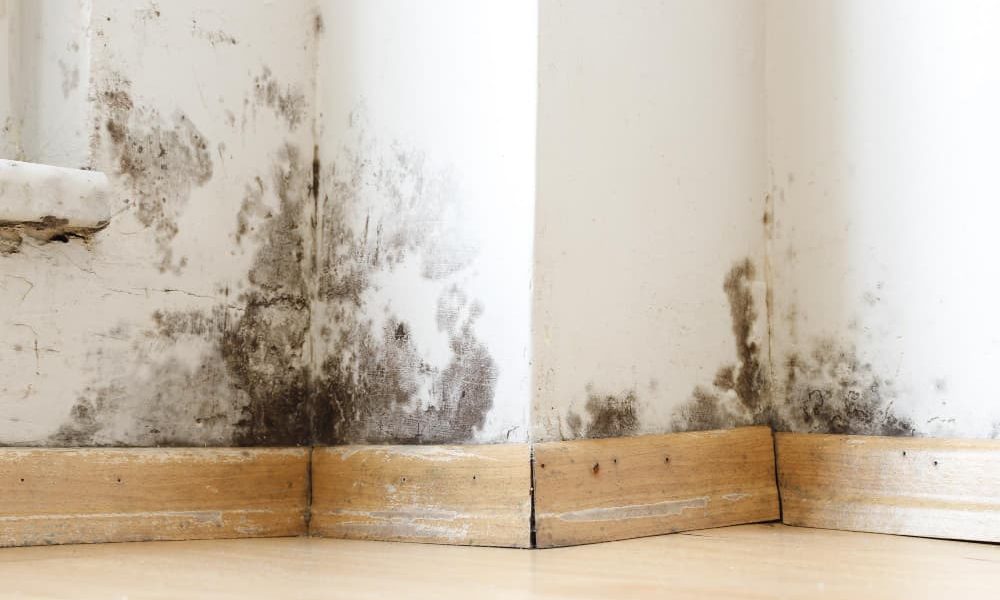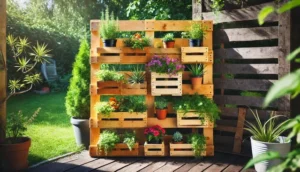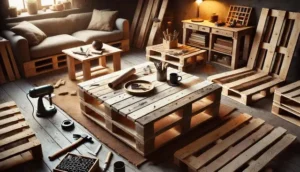In today’s world, sustainability is no longer just a buzzword—it’s a necessity. With rising concerns about environmental impact, more people are looking for ways to reduce waste and extend the life of items they already own. This is where upcycling comes into play.
Upcycling is the process of taking an old or unused item and giving it new life by transforming it into something functional or decorative. It’s a practice that not only reduces waste but also allows for creative expression. Unlike recycling, which often breaks down materials into raw forms to create new products, upcycling keeps the item intact while enhancing its value. By upcycling, you’re reducing the number of items that end up in landfills and minimizing the need for new raw materials, thus contributing to a more eco-friendly lifestyle.
One of the most rewarding aspects of upcycling is the potential to create unique, one-of-a-kind pieces. You don’t have to be a professional craftsman or designer to take part in this movement. Simple projects, like transforming an old dresser into a functional and stylish TV stand, are a perfect way to start. This project is ideal for those looking to give new life to an outdated piece of furniture and avoid the cost of buying a brand-new TV stand.
In this guide, we will walk you through every step of upcycling a dresser into a TV stand. You’ll learn about the tools, materials, and techniques needed to complete the project, along with tips for adding a personal touch to make it your own. Whether you’re a seasoned DIYer or a beginner, this guide will help you create a custom TV stand that fits your home’s style and needs.
Materials Needed for Upcycling an Old Dresser
Before jumping into the project, it’s essential to gather the necessary tools and materials. Having the right supplies on hand will save you time and make the process smoother. The good news is that many of the items you’ll need can be found around your home, at local hardware stores, or even at second-hand shops, aligning with the upcycling ethos of reducing waste and reusing what’s available.
Essential Tools and Supplies
To get started, you’ll need the following tools and materials:
- Old Dresser: The centerpiece of your project. Choose a dresser that’s structurally sound with a flat top and enough storage space for your entertainment system. Don’t worry about cosmetic imperfections like scratches or outdated finishes—those can be fixed later in the process. If you don’t already have a dresser to upcycle, consider checking out thrift stores, garage sales, or online marketplaces for affordable options.
- Sandpaper or Electric Sander: Sanding the dresser is a critical step in prepping it for a new finish. Whether you use basic sandpaper or an electric sander, make sure to choose a variety of grit sizes (coarse, medium, and fine) to smooth out any rough spots and prepare the surface for paint or stain.
- Screwdriver or Drill: You’ll likely need to remove old hardware, such as drawer pulls or knobs, and possibly disassemble parts of the dresser. A basic screwdriver or power drill will help with this step. A drill is also essential if you need to add new holes for hardware or adjust the structure of the dresser to accommodate electronics.
- Wood Filler: If your dresser has deep scratches, holes, or other surface imperfections, wood filler will be your best friend. This material fills in damaged areas and can be sanded down for a smooth finish before painting.
- Primer and Paint: Depending on the look you’re going for, you can either paint the dresser a bold color to match your room’s aesthetic or use a neutral tone for a minimalist design. Make sure to choose a primer that’s compatible with the type of paint you’ll be using, whether it’s latex, oil-based, or chalk paint.
- New Hardware (Optional): Upgrading the hardware on your dresser can give it a completely new look. Consider adding new drawer pulls, knobs, or hinges to match the overall style of your room and enhance the functionality of the TV stand.
- Measuring Tape and Pencil: Precision is key when transforming a dresser into a TV stand, especially when making adjustments for shelves or openings for cables. A measuring tape and pencil will help ensure everything fits properly.
- Saw (Optional): If you’re planning to remove drawers or modify the dresser to create open shelving for media devices, a saw may be necessary. You can use a hand saw or an electric one, depending on the extent of the modifications.
- Clear Finish or Sealant: Once you’ve painted or stained the dresser, a clear finish or sealant will help protect the surface from scratches, water damage, and everyday wear and tear. This final layer will ensure your TV stand stays in great shape for years to come.
Where to Find Affordable or Second-Hand Items
One of the beautiful things about upcycling is that it encourages resourcefulness. You don’t have to spend a fortune on brand-new materials to complete this project. Many of the supplies mentioned above, like wood filler, sandpaper, and paint, are relatively inexpensive. You can also save money by sourcing your dresser and other tools second-hand.
Start by browsing your local thrift stores, flea markets, or garage sales for an old dresser. Online marketplaces like Craigslist, Facebook Marketplace, or even Freecycle are great places to find used furniture at a fraction of the cost—or sometimes even for free. When searching for materials, consider asking friends or family if they have any extra paint, hardware, or tools they’re no longer using.
Not only will shopping second-hand save you money, but it also supports the core principle of upcycling: reusing and repurposing items to reduce waste.
Step 1: Choosing the Right Dresser for Upcycling
One of the most exciting parts of upcycling is selecting the piece you’re going to transform. Choosing the right dresser for your upcycled TV stand project is crucial, as it sets the foundation for the final product. Not every dresser is suitable for upcycling into a TV stand, so it’s important to keep a few key factors in mind before diving into the project.
How to Select the Perfect Old Dresser for Upcycling
When selecting a dresser, consider its size, structure, and condition. The ideal dresser should be wide and low enough to accommodate your television and media equipment. Taller, narrow dressers might not work well as a TV stand, as they may not offer enough stability or surface area. A good rule of thumb is to make sure your TV can sit comfortably on top of the dresser without hanging over the edges. You’ll also want to ensure that the dresser has enough depth to house any electronic devices, such as gaming consoles, sound systems, or cable boxes.
Structural Integrity Matters Ensure that the dresser is structurally sound. Check for any major cracks, weak joints, or wobbly legs, as these could compromise the sturdiness of your new TV stand. While minor issues like surface scratches or peeling paint can be fixed easily, deeper structural damage may require more advanced repairs. If you’re not comfortable with making significant repairs, it’s better to choose a dresser in better condition.
Consider Drawer Layout and Functionality A dresser with multiple drawers can be ideal, as it provides ample storage for DVDs, remotes, and other media accessories. However, you’ll likely want to modify the layout, especially if you need space for electronic devices. Open shelving may be required to provide airflow and easy access to cables. When selecting your dresser, consider how the drawer configuration can be modified to suit your needs.
Where to Find the Perfect Dresser
Once you have an idea of the type of dresser you need, it’s time to start hunting. As mentioned earlier, thrift stores, flea markets, and online platforms like Craigslist and Facebook Marketplace are fantastic places to find affordable, second-hand dressers. You might even come across vintage pieces that will add character and charm to your living space. Don’t be afraid to negotiate prices—many sellers are open to bargaining, especially if the dresser has seen better days.
Step 2: Prepping Your Dresser for Upcycling
Now that you’ve selected your dresser, it’s time to prep it for its transformation. Proper preparation is key to ensuring your final product looks polished and professional.
How to Properly Prep an Old Dresser for Upcycling
Before making any modifications, start by giving your dresser a thorough cleaning. Dust, dirt, and grime can build up over time, especially on older pieces. Use a damp cloth or sponge with mild soap and water to clean the surface. For tougher spots, a mixture of vinegar and water can work wonders. Be sure to dry the dresser completely before moving on to the next steps.
Remove Hardware Next, remove any old hardware, including knobs, pulls, and hinges. These can be unscrewed with a basic screwdriver or drill. Save the hardware if you plan to reuse it, but this is also an excellent opportunity to replace outdated hardware with something more modern or stylish.
Sanding the Dresser Sanding is an essential step in prepping your dresser for paint or stain. If the dresser has a glossy or chipped finish, sanding will help create a smooth, even surface. Use a coarse-grit sandpaper (80-100 grit) to remove the old finish, then switch to finer grit (150-220 grit) for a smooth surface. Be sure to sand along the grain of the wood to avoid scratches.
For dressers with intricate carvings or details, a sanding sponge or a small, detail-oriented tool may be necessary. Once the sanding is complete, wipe down the dresser with a damp cloth to remove any dust or debris.
Fill Imperfections If your dresser has any noticeable dents, scratches, or holes, now is the time to fill them. Use wood filler to patch up imperfections, applying it with a putty knife. Allow the filler to dry completely, then sand it down to create a smooth surface.
Prime for Paint Priming is a critical step before applying paint. A good primer helps paint adhere better and provides a more even finish. Depending on the material of your dresser (wood, laminate, etc.), choose a primer suited to that surface. Apply one or two coats of primer, making sure to let each coat dry fully before moving on to the painting stage.
Step 3: Designing Your TV Stand
Here’s where your creativity comes into play! The design phase is all about customizing the dresser to suit your aesthetic preferences and functional needs. Whether you want a sleek, modern look or a rustic, farmhouse vibe, this is your chance to personalize the piece and make it unique.
Creative Design Ideas for Upcycling a Dresser into a TV Stand
There are countless ways to modify your dresser and transform it into the perfect TV stand. Here are a few design ideas to consider:
- Modern and Minimalist For a modern look, paint the dresser in a bold color, like matte black, navy, or emerald green. Swap out old hardware for sleek, metal pulls in brushed gold or silver. Consider removing one or two drawers and replacing them with open shelving for a minimalist, uncluttered design.
- Rustic and Farmhouse If you’re going for a rustic or farmhouse style, distressed finishes and natural wood tones work well. Sand down the dresser to reveal the raw wood beneath, then apply a whitewash or light stain to enhance the natural grain. Pair this look with vintage-inspired hardware, like cast iron or antiqued brass.
- Industrial Chic For an industrial look, combine wood and metal elements. Paint the dresser in neutral shades like gray or charcoal, and incorporate metal hardware or accents. You could even add industrial-style casters to the bottom for a functional and edgy touch.
- Coastal or Bohemian For a light and airy feel, consider pastel shades like light blue, seafoam green, or soft pink. These colors evoke a coastal or bohemian vibe, perfect for a relaxed living space. Add natural accents like woven baskets, macramé, or rattan accessories to complete the look.
How to Plan the Layout for Shelves and Cable Management
When upcycling a dresser into a TV stand, functionality is just as important as aesthetics. You’ll need to plan for open shelving to house media devices, as well as manage cables and wiring to keep things tidy.
Open Shelving To create space for media devices, you may need to remove some of the drawers and install shelves in their place. This allows for airflow and easy access to gaming consoles, DVD players, or soundbars. Measure the height and width of your devices before removing the drawers to ensure the shelving will fit.
Cable Management One common issue with TV stands is dealing with the tangle of cables from multiple devices. To solve this problem, consider drilling small holes at the back of the dresser to feed cables through. You can also install cable management systems, like clips or trays, to keep everything organized and out of sight.
Step 4: Modifying the Structure of the Dresser
Once your dresser is prepped and you’ve settled on a design, it’s time to dive into the structural modifications. This stage is where your dresser begins its transformation from a simple piece of furniture into a fully functional TV stand. While this part of the process can seem daunting, it’s entirely doable with the right tools and a bit of patience.
How to Modify an Old Dresser for a TV Stand Conversion
The primary structural change for most upcycling projects involving a dresser-to-TV stand conversion is the removal of drawers. Depending on your design plan, you may decide to keep some drawers for storage or remove them all to create open shelving.
Step 1: Remove Drawers Start by carefully removing the drawers from the dresser. If you plan on repurposing the drawer fronts or using the space for shelving, keep these pieces intact. Otherwise, you can set them aside or use the wood for other creative projects. Be sure to remove any drawer tracks, runners, or hardware that you won’t be using.
Step 2: Install Shelving Once the drawers are removed, it’s time to install shelves in their place. These shelves will house your media devices, such as gaming consoles, DVD players, or streaming boxes. Measure the space where the drawers used to be to determine the size of the shelves you’ll need. You can either repurpose the wood from the drawer fronts or use new wood from a hardware store.
Cut the shelves to size and secure them using L-brackets or wooden supports screwed into the inside walls of the dresser. Ensure that the shelves are level and strong enough to support the weight of your devices.
Step 3: Create Openings for Cable Management To keep your setup looking tidy, you’ll need to create openings at the back of the dresser for cables. Using a hole saw attachment on your drill, cut circular holes in the back panel of the dresser. These should be large enough to feed power cords and HDMI cables through but small enough to maintain a clean look.
Step 4: Reinforce the Structure (Optional) If your dresser is particularly old or has been weakened over time, reinforcing the structure may be necessary to ensure it can support the weight of your TV and devices. This can be done by adding corner braces to the inside of the dresser or reinforcing the legs with additional screws or brackets.
Taking these structural steps will help ensure that your upcycled dresser functions smoothly as a TV stand, offering both style and utility.
Step 5: Painting and Finishing Touches
With the structural modifications complete, it’s time to focus on the finishing details. This is the stage where your upcycled dresser really starts to take shape, transforming from a functional project into a piece of art that reflects your personal style. The painting and finishing process allows you to customize the dresser, whether you’re aiming for a sleek, modern look or a rustic, vintage aesthetic.
Best Paints and Finishes for Upcycling Wood Furniture
Choosing the right paint and finish is crucial to achieving the desired look and ensuring that your upcycled TV stand is durable and long-lasting. Here are some popular options:
Chalk Paint: Chalk paint is a favorite among DIYers for its matte finish and versatility. It adheres well to most surfaces without the need for extensive sanding, making it ideal for older furniture. Plus, it’s available in a wide range of colors, so you can easily find a shade that matches your decor.
Latex Paint: For a more durable finish, latex paint is a great choice. It’s available in various sheens (flat, satin, semi-gloss, and gloss) and provides a smooth, professional look. Be sure to use a primer before applying latex paint to ensure proper adhesion.
Milk Paint: If you’re going for a vintage or distressed look, milk paint is an excellent option. This eco-friendly paint gives furniture an authentic, old-world charm with a slightly textured finish. It works well for rustic or farmhouse styles.
Stain: If you prefer a natural wood look, staining the dresser instead of painting it may be the way to go. Wood stains come in a variety of tones, from light oak to dark mahogany, allowing you to highlight the natural grain of the wood. Apply a clear sealant afterward to protect the surface.
Techniques for Painting and Distressing
Once you’ve selected your paint or stain, it’s time to start applying it. Here are a few techniques to keep in mind:
Step 1: Apply Primer Before applying paint, it’s essential to prime the surface, especially if the wood is old or has a dark finish. A good primer helps the paint adhere better and provides a uniform base. Allow the primer to dry completely before moving on to the paint.
Step 2: Paint or Stain When painting, use a high-quality brush or roller to apply the paint in thin, even coats. It’s better to apply multiple thin layers than one thick coat, as this will prevent drips and create a smoother finish. Be sure to let each coat dry fully before applying the next.
If you’re staining the dresser, use a clean cloth to wipe the stain onto the wood, following the direction of the grain. Apply multiple coats as needed to achieve the desired color, wiping off any excess after each application.
Step 3: Distress (Optional) For a distressed look, lightly sand the edges and corners of the dresser after the paint has dried. Focus on areas that would naturally show wear over time, such as drawer fronts or legs. This technique adds character and a vintage feel to the piece.
Step 4: Apply a Clear Coat To protect your work, apply a clear finish or sealant. This is especially important if the TV stand will be placed in a high-traffic area or exposed to wear and tear. Choose a finish based on the look you’re going for—matte, satin, or glossy.
Adding the Final Touches
Once the painting or staining is done, it’s time to add the finishing touches that will bring your upcycled TV stand to life.
Replace or Upgrade Hardware Replacing old drawer pulls or knobs with new hardware is a quick and easy way to give the dresser a modern update. Consider using metal, ceramic, or even vintage-inspired hardware to match the overall design of the room. For an added touch of personalization, you can even paint the hardware to complement the dresser’s new look.
Add Decorative Elements To truly make your TV stand unique, consider adding some decorative elements. For example, you could line the inside of the shelves with patterned wallpaper or fabric, or add decorative molding around the edges of the dresser for a more polished appearance.
With the structural modifications complete, the paint applied, and the finishing touches in place, your upcycled dresser is now a beautiful, functional TV stand ready to be showcased in your home.
Step 6: Assembling and Installing the TV Stand
With your newly upcycled dresser transformed into a stylish TV stand, it’s time to put everything together and install it in your living space. This step ensures that your creation is not only functional but also stable and secure. After all, a TV stand holds valuable electronics, and safety is paramount.
How to Properly Assemble and Secure Your Upcycled TV Stand
Before you place your TV and media devices on the dresser, make sure it’s sturdy enough to support the weight. Here’s a step-by-step guide to assembling and securing your new TV stand:
Step 1: Double-Check the Stability Ensure that all structural modifications, such as new shelves and reinforced joints, are secure. If you added shelves, test their stability by placing heavier items on them to ensure they can handle the weight of your devices. If the dresser feels wobbly, consider reinforcing the legs or adding extra supports.
Step 2: Position the TV Stand Choose the right spot in your living room or entertainment area for the TV stand. Ideally, place it against a flat wall to maximize stability and to ensure it can easily accommodate your TV and other media devices. The TV stand should be positioned at a height that’s comfortable for viewing, typically at eye level when seated.
Step 3: Mount the TV (Optional) If you plan on mounting the TV to the wall above the stand, this is the time to do it. Make sure to use a sturdy wall mount that can hold the weight of your TV. Once mounted, the dresser will act as a support for media devices, gaming consoles, or decorative items.
Step 4: Organize Cables and Wires Cable management is crucial to maintaining a clean, organized look. Feed all cables through the holes you created at the back of the dresser to keep them out of sight. Use cable clips, ties, or trays to prevent tangling and to keep the wires organized. This step not only improves aesthetics but also makes it easier to access and manage your electronics.
Step 5: Test for Stability Once your TV and media devices are in place, give the stand a final stability check. Test its sturdiness by gently pushing or pulling it to ensure it doesn’t wobble. If necessary, use anti-tip hardware to secure the dresser to the wall, especially if the TV stand will be in a home with children or pets.
Step 7: Styling Your New TV Stand
Now that your upcycled TV stand is assembled and functional, it’s time to add some personal touches to make it a stylish focal point in your living room. Styling the area around your TV stand can elevate the look of your space and tie everything together.
Creative Ways to Style Your Upcycled Dresser TV Stand
- Balance Function and Aesthetics While the TV stand’s primary function is to hold your television and media devices, it doesn’t mean you have to sacrifice style. Use the shelves and drawers for both practical and decorative purposes. For example, you can store DVDs, remotes, and game controllers in the drawers while leaving space for decor items on the shelves.
- Add Plants for a Fresh Touch Incorporating plants around your TV stand adds a touch of nature and freshness to the space. Small potted plants or succulents on the top or sides of the dresser can break up the sharp lines of electronics and make the area feel more welcoming.
- Use Decorative Baskets If you need additional storage, decorative baskets are both functional and stylish. Place them inside the dresser’s open shelves to store items like cables, magazines, or game controllers while keeping them hidden. Woven or fabric baskets add texture and warmth to the space.
- Incorporate Artwork or Frames Don’t be afraid to personalize the space with framed artwork, family photos, or decorative objects. You can place a few frames on top of the dresser or mount them on the wall behind the TV. Be mindful of balance and ensure that these elements don’t compete with the TV as the focal point.
- Create Symmetry If your dresser has a wider top, you can use symmetry to style the space effectively. Place matching items, such as lamps or vases, on either side of the TV. Symmetry creates a clean and organized look that’s visually appealing.
Tips for Organizing and Storing Electronics
Keep Cables Organized: One of the biggest challenges with media setups is managing the tangle of cables from TVs, gaming consoles, sound systems, and more. Use cable ties or clips to bundle cords together, and store any excess wire length behind the dresser to keep everything neat.
Designate Storage for Remotes and Small Items: Drawers are a great place to store smaller items like remote controls, batteries, and video game controllers. Use drawer organizers to keep these items easily accessible and prevent clutter.
Maintain an Open Layout for Ventilation: If you have media devices like gaming consoles, DVD players, or sound systems stored on the shelves, make sure they have proper ventilation. Avoid overloading the shelves with decor, as electronics need airflow to prevent overheating.
Conclusion
Upcycling an old dresser into a TV stand is not only a fun and creative project but also an environmentally friendly way to repurpose furniture. By taking the time to carefully select, modify, and style your dresser, you’ll have a unique, custom piece that reflects your personal style and enhances the look of your living room.
In addition to saving money by avoiding the purchase of a new TV stand, you’re also contributing to a more sustainable way of living. Upcycling reduces waste, extends the life of materials, and allows you to create something entirely your own.
Whether you’ve chosen a sleek, modern design or embraced a more rustic, vintage style, your upcycled TV stand is sure to become a statement piece in your home. With the step-by-step guide provided, even beginner DIYers can take on this project with confidence.
Bonus Tips: Expert Advice for Successful Upcycling Projects
As a final note, here are a few bonus tips from expert upcyclers to keep in mind as you tackle this project:
- Take Your Time: Rushing through steps like sanding, priming, or painting can lead to subpar results. Take the time to do each step properly, and allow paint or stain to dry fully between coats.
- Experiment with Different Finishes: Don’t be afraid to try different finishes or textures. Mixing matte and glossy finishes can add depth and interest to your project.
- Don’t Overcomplicate the Design: Sometimes simplicity is key. If you’re new to upcycling, start with a straightforward design and make small modifications as needed.
- Have Fun and Be Creative: Upcycling is all about creativity. Don’t hesitate to try new things, experiment with different styles, and most importantly, enjoy the process!
With these tips and steps in mind, you’re ready to embark on your upcycling journey. Your old dresser is just waiting to become the star of your living room, transformed into a functional and beautiful TV stand that you’ll be proud to showcase.







